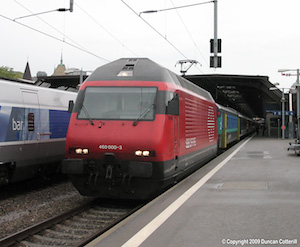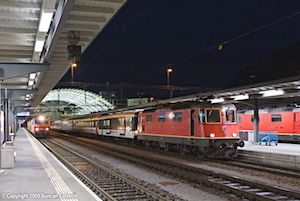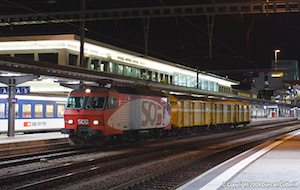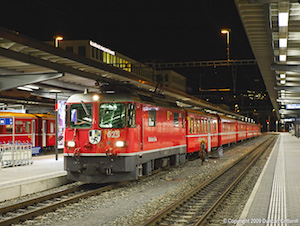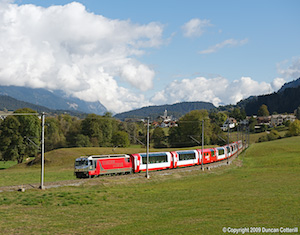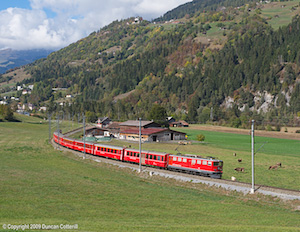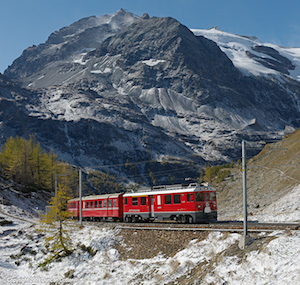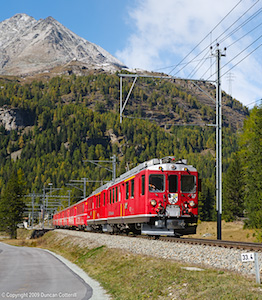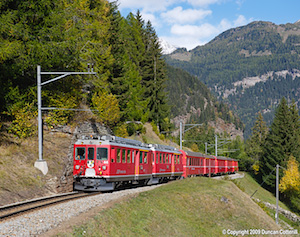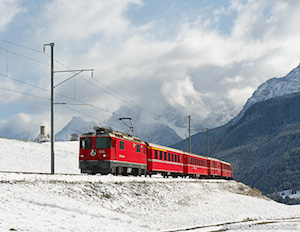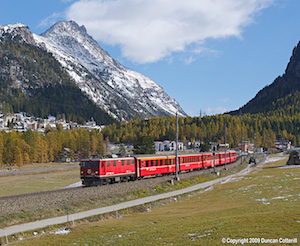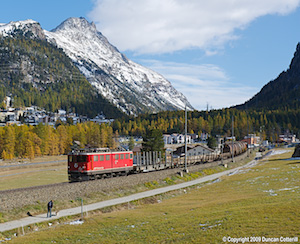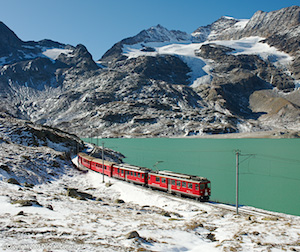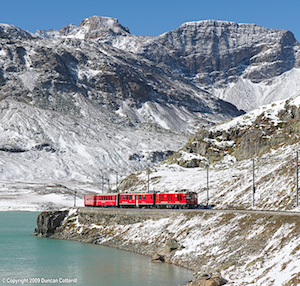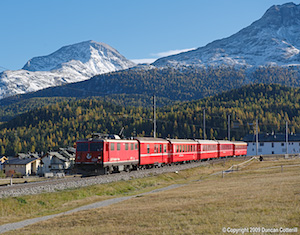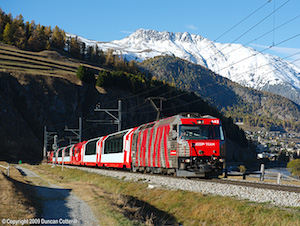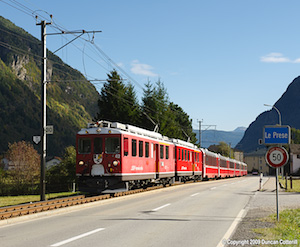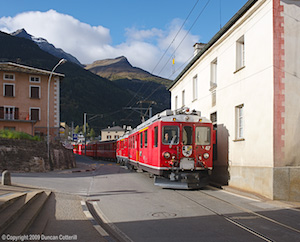Autumn on the Rhätischebahn
08 -16 October 2009
Report by Duncan Cotterill
Introduction
The Rhätischebahn operates an extensive network of meter gauge lines in the mountainous south-eastern Swiss canton of Graubünden, linking the regional capital, Chur, with the principal towns of the region, including the popular resorts of Klosters, Davos and St. Moritz. It’s a photographer’s dream with superb scenery, attractive liveries and frequent trains, many of them loco hauled.I didn’t expect to be doing a winter trip quite this early in the year but the weather had other ideas. My three previous to Graubünden had all been blessed with clear blue skies and lots of sunshine but this trip evened up the balance a bit.
Note that the summer timetable was in operation at the time of my visit but the winter timetable came into operation on 19 October with a reduction in the number of trains on some routes. As a result there will almost certainly have been some changes and probably less work for the older engines.
Passenger Services
Schiers – Rhäzüns & Chur – Thusis
These local services were operated by class Be4/4 motor coaches and trailers. The motor coach was always at the Schiers/Chur end of the formation. Motor coaches 511, 512, 513, 515 were seen in use.Landquart – Davos Platz
The Landquart – Davos service was diagrammed to be operated by three Ge4/4III on a 3-day diagram and two Ge4/4II on a separate 2-day diagram. Trains were worked push-pull with the loco at the Davos end of the set. Additional coaches were often added at the back, particularly on busy days, meaning the loco could be in the middle of the train on services from Davos. There are no spare Ge4/4III so, because 652 was in works, a Ge4/4II substitute was required to cover one of the Ge4/4III turns. 613, 614, 632, 641, 643, 649, 650 were all seen on Landquart – Davos or the associated Davos – Filisur trains.Davos Platz – Filisur
This service was operated as an extension of the Landquart – Davos route with the same loco and push-pull set but no extra coaches. The loco was always at the Filisur end of the train.Chur St. Moritz
Most trains were operated by six Ge4/4III on a 6-day diagram which included some Glacier Express workings as well. This meant that two Ge4/4II were required as well in order to cover all the regular Chur – St. Moritz workings. In addition, there were occasional substitutions of Ge4/4II for Ge4/4III and on 13 October Ge4/4I 609 worked train RE1120. In the past, shortages of Ge4/4III have been covered by using a Ge6/6II to work one of the Ge4/4III turns but this practice wasn’t seen at all on this trip. There was, however, a turn for a Ge6/6II covering trains RE1133 and RE1148 on Saturdays and Sundays, worked by 701 on 10 October. 612, 615, 620, 621, 622, 624, 633, 641, 642, 644, 646, 647, 648, 650, 651 were all seen on the Chur – St. Moritz trains. 642, 646, 647, 648 and 651 were regular performers while the rest came and went.Disentis/Muster – Scuol-Tarasp
Virtually all trains were booked to be worked by class Ge4/4II locos but Ge6/6II 707 was noted covering trains on this route on three different days, presumably to release a Ge4/4II to work the Davos line. All trains were terminating at Ardez due to tunnel work between there and Scuol-Tarasp. 611, 612, 613, 615, 616, 618, 619, 621, 622, 624, 625, 626, 631, 632, 633, 707 were all seen.Chur – Arosa
This line was worked by class Ge4/4IIs on push-pull sets with the loco at the Arosa end of the formation. As on the Davos line, additional coaches could be added to the back, sandwiching the loco in the middle on the trip down from Arosa. A few early morning trains (1415 & 1420 on Mo & Fr and 1411 & 1414 on Tu – Th) were booked for a Ge4/4I, also on a push-pull set but none of these trains were actually seen. 617, 623, 629 were seen on Arosa workingsPontresina – Scuol-Tarasp
Two class Ge4/4I and two class Ge4/4II worked a 4-day diagram covering these trains. All workings were push-pull with the loco at the Scuol-Tarasp end of the train. As with the Disentis trains, all services terminated at Ardez. One day of the diagram involved the loco working a few early morning and late evening trains around the Oberengadin, while the other three days covered the hourly service throughout the day. This meant that on some days there were two Ge4/4Is and one Ge4/4IIs about and on other days it was the other way round. 602, 610, 612, 627, 630 were all seen on these services.St. Moritz – Tirano
While the diagrams for the main RhB system proved very accurate and the vast majority of trains operated as expected, the Bernina seemed to do it’s own thing. Even the daily allocation sheets couldn’t be relied on. Anything could turn up on any train and the only combination I didn’t see was the two Gem 4/4 electro-diesels double heading. Both Gem4/4s were diagrammed to work daily but I never saw more than one out on any one day and sometimes neither was in use. 41, 42, 43, 44, 45, 46, 47, 48, 49, 51, 52, 53, 54, 55, 56, 801, 802 were all seen in use, i.e the entire Berninabahn roster!Other Passenger Services
One train that didn’t fit into the usual regular interval pattern was the “Engadin Star”, the 08:20 from Landquart via Klosters, the Vereina Tunnel and the Unterengadin to St. Moritz and the 16:35 return. On Saturdays and Sundays there was a second pair of trains one hour later in each direction. The “Engadin Star” was booked for a Ge4/4I on Mondays to Saturdays while the Sunday trains and the weekend extras were diagrammed for Ge4/4IIs. 601, 603, 609 were all seen, as was 620 on a Saturday when the train should have been Ge4/4I hauled.Another unusual working booked for Ge4/4I haulage was RE1250, the 17:24 from Chur to Ilanz on Mondays to Fridays. This was booked to use the same loco and push-pull set that worked the early morning Arosa trains. The return from Ilanz was empty stock.
Tourist Trains
There seem to be more and more Glacier Express and Bernina Express workings on every visit. These trains are operated with “Panoramawagen”, coaches with large windows that wrap around into the roof allowing the inmates to gawp at the scenery. A supplement applies and prior reservation is supposedly compulsory although most trains seemed to have spare seats.The Glacier Express ran in four sections this summer, each of around six coaches. Three sections ran from St. Moritz to Zermatt and one from Davos to Zermatt. Two of the St. Moritz sections were combined and ran as a separate train all the way to Disentis, the third section was attached to a regular train from St. Moritz to Chur where it was combined with the section from Davos for the run to Disentis.
This method of working resulted in some very long trains and a note on the daily allocation sheet required that, apart from the Davos – Chur segment, the Glaciers were worked by Ge4/4III locos due to air supply considerations. These workings formed part of the 6 day Chur – St. Moritz Ge4/4III diagram. The Davos section was booked for a Ge4/4I as far as Chur and 609 was noted on this train on 10 October.
From Disentis, each section was worked forward as a separate train by the MGB.
The Bernina Expresses from Chur and Davos to Tirano were worked as far as Pontresina by Ge4/4Is, although the Chur train was worked by a Ge4/4II at weekends. At Pontresina the coaches were coupled behind a pair of power cars (of either type) for the run over the Bernina Pass to Tirano. In addition, a number of St. Moritz to Tirano trains operated as Bernina expresses with a pair of power cars hauling Panoramawagen. It’s not well publicised but it is possible to travel in the motor coaches on these workings, presumably without a reservation or paying the supplement. Note that the Gem4/4s were seen on eight different trains but never on a Bernina express. North of Pontresina, 601, 603, 606 were all seen with 618, 630 on weekend trains from Chur as expected.
Freight Workings
Freight traffic is remarkably heavy on the RhB particularly on the Chur/Landquart to Samedan/Pontresina route with several trains in each direction on Mondays to Fridays. More freight is attached to the rear of regular passengers trains, particularly between Samedan and Thusis. Other routes see varying amounts of freight with workings to Ilanz, Disentis and Davos on weekdays. With the Scuol-Tarasp line closed east of Ardez, freights booked to go to Scuol were terminating at Zernez instead. The seven Ge6/6II handled the majority of freights with a few Ge4/4I and Ge4/4II handling shorter distance workings around the Chur/Landquart area. Of note were ballast workings from a quarry at Schiers to the Arosa line. One of these trains was seen leaving Chur for Lüen-Castiel with double-headed Ge4/4II on the evening of Friday 9 October.The Bernina carries a significant volume of freight traffic, most of it attached to the rear of ordinary passenger trains between Pontresina and either Poschiavo or Campocologno. Oil tankers and timber wagons form the bulk of the traffic.
Vereina Tunnel Shuttles
Three Ge4/4IIIs were allocated to these workings although the service was generally covered by two locos with the third on standby to cover failures or additional services at times of high demand. 645 was permanently on these trains (best place for it) assisted on most days by 643 and 644.SBB Chur Area
Class 460 class locos worked all the Chur – Zürich IC services seen and around half the IR trains on the same route. Re4/4IIs worked the remaining IR trains and all the Chur – St. Gallen RE trains. Local services seen were all EMUs. A number of Cisalpino liveried coaches were seen were seen in the consists of the IR and RE trains. The IC trains were all push-pull double deck sets with the loco at the Zürich end but everything else was hauled.Most of the few freights seen were Re420 worked and often double-headed. One Ae6/6 hauled freight was seen and one Re6/6 was stabled at Landquart. SOB 446 018 was seen on a mail train at Chur on the evening of Friday 9 October.
Photography
The weather was rather different to my three previous trips to the RhB, particularly the warm, sunny days enjoyed in October 2007. Even on my midwinter trips, the skies were blue and there was plenty of sunshine.Not this time. It was very dull when I arrived on Thursday afternoon and stayed that way until Sunday when the sun put in a brief appearance. The temperature dropped and the first snow fell on Sunday night. From Monday onwards the weather settled into a pattern of sorts with cloud to the north and clear skies to the south. Each day started with a trip southwards to find the sun. Occasionally the Engadin was clear but I usually had to continue south onto the Bernina to get away from the clouds. Apart from a brief visit to the Disentis line on the Sunday, the rest of the system wasn’t photographed at all.
Fortunately there are plenty of locations in the Engadin and on the Bernina so the time wasn’t wasted. Both areas also featured classes that were threatened with early withdrawal, the Ge4/4I Bo-Bos on the main system and the Be4/4II motor coaches and Gem4/4 electro-diesels on the Bernina. The snow added another dimension to the photography with frequent falls followed by rapid melting often changing the scene noticeably from one train to the next.
I hadn’t intended spending so much time on the Berninabahn but found it a very rewarding line to photograph with a huge variety of locations; everything from street running in Le Prese through the pastures and forests of the lower slopes to the beautiful desolation of the Bernina Pass itself, surrounded by rocky peaks and glaciers.
Logistics
I flew with British Airways from Heathrow to Zürich then travelled by train to Chur, buying a single ticket at Zürich Flughafen. Once in Chur I bought a “Monats BÜGA”, which is a pass giving a month’s free travel on all trains, most buses and a few cable cars in the canton of Graubünden. The logic of buying a monthly ticket for a 9 day trip may not be obvious but it’s the most cost effective option for all but the shortest trip, provided you’re content to remain within the borders of Graubünden. The entire RhB network is included, even the section from Campocologno over the border to Tirano in Italy, as well as a short stretch of the SBB main line between Chur and Bad Ragaz and the MGB as far west as Oberalppasshöhe. At SFr270 for a first class ticket it’s not cheap but neither are any of the other options, especially buying individual tickets. A first class return from Chur to Tirano will set you back SFr190.I had hoped to base myself at the Hotel Grischuna in Filisur for the whole trip. Unfortunately they were full until the Saturday so I spent the first two nights at the Hotel Post in the centre of Chur, about 5 minutes brisk walk from the station. The remainder of the trip was spent at the Grischuna.
Information
The RhB is one of the most gricer friendly railways on the planet and publishes its graphical timetables, including freights and ECS workings as well as the loco diagrams. If you’re based in Bergün or Filisur it’s usually possible to obtain a copy of the workings for the following day at the station after about 17:00 the previous evening.Future Developments
For a couple of years, the threat of new units displacing the more interesting locos has been a concern. Well, it’s about to become a reality. The local paper for Thursday 15 October carried a picture of the first unit being offloaded at Landquart together with a statement from RhB management that they would be introduced on the Bernina, Chur-Arosa, Chur/Landquart area locals and Landquart – Davos services from the start of the summer timetable in May 2010. The Landquart – Davos trains are a real surprise as this is probably the second most important service on the system after the Chur – St. Moritz route. The Landquart – Davos and Chur – Arosa trains can be very long in the peak tourist seasons and some of the Bernina trains are quite long as well. Assuming that the RhB don’t try replacing 9 coach trains with a single 3-car unit, there don’t seem to be enough new units to go round. Another unanswered question is how the Bernina will be worked when the new units replace the ABe4/4II motor coaches. I can’t imagine a “Flirt” dragging three bogie oil tankers up the 1 in 14 gradients to Ospizio Bernina like the current motor coaches do on a daily basis.Whatever happens, the number of loco hauled trains on the RhB will decrease and the number of Ge4/4Is in traffic is bound to decline significantly. The next winter sports season from late December 2009 to mid-March 2010, when extra trains run, may be the last chance to see these fine old engines in widespread use.
